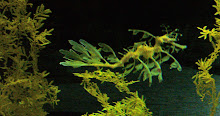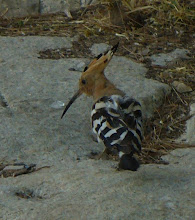Hi. Welcome to weirdbeautiful.
First link of the day today is this odd story in the British tabloid newspaper "The Sun" of a body-boarder who claims he was bitten by a tropical sea snake off the coast of Cornwall (England)-
http://www.thesun.co.uk/sol/homepage/news/3067153/Tourist-believes-he-was-bitten-by-a-tropical-sea-snake-off-the-coast-of-Cornwall.html
Quite a few snakes have venoms that cause their victims to bleed from their mouths in the aftermath of being bitten. Similarly, the bite site oozing fluid and blood is characteristic of a lot of snake bites, including that of the adder (Vipera berus)(something -the badly swollen, oozing wounding- I got to witness at first hand, when my dog was bitten by a snake a few years ago).
The Sun is also hosting this impressive gallery-
http://www.thesun.co.uk/sol/homepage/features/3067121/Amazing-wildlife-pictures-from-photographer-Scott-Linstead.html
- of wildlife images by Canadian teacher-turned photographer Scott Linstead.
Wednesday, 28 July 2010
Sunday, 25 July 2010
Insect photographs

Hi. Welcome (back) to Weirdbeautiful. Thanks for stopping-by. The weirdlybeautiful creature above is a grasshopper species that I am currently "culturing" on my windowsill. Grasshoppers are famously noisy creatures, but this particular species seems to be almost totally silent- so far, at least.
Over the past few weeks, I have been heavily involved in both entomological and botanical and wildlife photography projects- the pictures below are what happens when photography and entomology collide...





All images in this post (c) Victoria Neblik, 2010. All rights reserved.
Labels:
14 spot,
bumblebees,
Entomology,
grasshoppper,
Insects,
ladybird,
pollination,
Victoria Neblik images
Quote of the week- James Anthony Froude- science rests on reason..belief is always sensitive
"Science rests on reason and experiment, and can meet an opponent with calmness; but a belief is always sensitive."
- James Anthony Froude (English historian and writer, 1818-1894)
- James Anthony Froude (English historian and writer, 1818-1894)
Wednesday, 21 July 2010
Iridescent Bees, Wasps, Ants and Sawflies...

Hi. Welcome (back) to Weirdbeautiful.
This is just a short personal post- I am happy to announce the publication of my book with Prof. Jean-Pol Vigneron (of The University of Namur), "Iridescent Bees Wasps Ants and Sawflies: structural colouration in the Hymenoptera".
This scientific book was the result of a 6-month preliminary-study (plus the time it took to write up)of colouration in bees, wasps, ants, sawflies and various of their relatives- ichneumon flies, for example. It was really to fill a gap in the scientific literature. The abstract will shortly be available on my website; a full-length preview is online at the printers's website [here], where copies are onsale.
Link of the day- odd trees and the wonders of faecal transplantation
Hi Welcome to Weirdbeautiful
Weird-link of the day today is this great article on the potential of faeces to heal... and the wonders of faecal transplantation-
http://www.nytimes.com/2010/07/13/science/13micro.html?src=me&ref=general
This is not really a new breakthrough, in the sense that the idea has been around for a little while (and previously reported elsewhere), but it is still an interesting story and - perhaps a timely reminder of the often overlooked power of bacteria.
The Beautiful link of the day is this gallery or photoessay on the world's strangest trees, by the search engine Bing-
http://www.bing.com/featured/content/search?q=Fantastic+Trees%3a+Baobab+%28Adansonia%29&FORM=RQHOME
starting with Baobabs and Rainbow Eucalyptus, the features has Sequioas, Jackfruits, Joshua trees, Wolemi Pines and a whole load of other strange trees- not least the magnificent "Dragon Blood Tree"...
Weird-link of the day today is this great article on the potential of faeces to heal... and the wonders of faecal transplantation-
http://www.nytimes.com/2010/07/13/science/13micro.html?src=me&ref=general
This is not really a new breakthrough, in the sense that the idea has been around for a little while (and previously reported elsewhere), but it is still an interesting story and - perhaps a timely reminder of the often overlooked power of bacteria.
The Beautiful link of the day is this gallery or photoessay on the world's strangest trees, by the search engine Bing-
http://www.bing.com/featured/content/search?q=Fantastic+Trees%3a+Baobab+%28Adansonia%29&FORM=RQHOME
starting with Baobabs and Rainbow Eucalyptus, the features has Sequioas, Jackfruits, Joshua trees, Wolemi Pines and a whole load of other strange trees- not least the magnificent "Dragon Blood Tree"...
Sunday, 18 July 2010
Quote of the week- Dmitri Mendeleev, pleasures and work

"Pleasures flit by - they are only for yourself; work leaves a mark of long-lasting joy, work is for others."
- Dmitri Mendeleev (1834-1907)
(image by Victoria Neblik.)
Wednesday, 14 July 2010
Links of the day- naturally multicoloured river and child psychology
Hi. Welcome to Weirdbeautiful
First link of the day today is this amazing set of photographs of a multi-coloured river in Colombia- the colours come from the mosses and algae growing on the river-bed and give it the local name "River of 5 colours":
http://www.stumbleupon.com/su/1unTKr/www.funzug.com/index.php/nature/most-colorful-river-in-the-world.html
(thanks to Stumbleupon.com for the link)
The second link is to this slightly more philosophical article by Pschiatry Professor, Dr Richard A. Friedman about the influence of nature and nurture in child personality development. In essence, what happens when good parents produce "bad" children-
http://www.nytimes.com/2010/07/13/health/13mind.html?src=me&ref=general
I have no idea why, but The International Herald Tribune seems to be a real well of good scientific articles and this one is no exception.
The final link for today is this stunning set of images from the Carl Zeiss photography competition in The Telegraph newspaper
http://www.telegraph.co.uk/science/picture-galleries/7887634/The-Carl-Zeiss-Photography-Competition-at-Cambridge-Universitys-Department-of-Engineering.html
First link of the day today is this amazing set of photographs of a multi-coloured river in Colombia- the colours come from the mosses and algae growing on the river-bed and give it the local name "River of 5 colours":
http://www.stumbleupon.com/su/1unTKr/www.funzug.com/index.php/nature/most-colorful-river-in-the-world.html
(thanks to Stumbleupon.com for the link)
The second link is to this slightly more philosophical article by Pschiatry Professor, Dr Richard A. Friedman about the influence of nature and nurture in child personality development. In essence, what happens when good parents produce "bad" children-
http://www.nytimes.com/2010/07/13/health/13mind.html?src=me&ref=general
I have no idea why, but The International Herald Tribune seems to be a real well of good scientific articles and this one is no exception.
The final link for today is this stunning set of images from the Carl Zeiss photography competition in The Telegraph newspaper
http://www.telegraph.co.uk/science/picture-galleries/7887634/The-Carl-Zeiss-Photography-Competition-at-Cambridge-Universitys-Department-of-Engineering.html
Sunday, 11 July 2010
Quote of the week- John Burroughs- joy in the universe
"Joy in the universe, and keen curiosity about it all - that has been my religion."
- John Burroughs, American Naturalist and Essayist (1837-1921)
- John Burroughs, American Naturalist and Essayist (1837-1921)
Thursday, 8 July 2010
Science update- the smell of jaguar...
Hi. Welcome (back) to Weirdbeautiful.
Weird wildlife story of the week is this piece (again, it is an extract from the news synopsis magazine "The Week", but a bit more upbeat than the previous extracts were)-
"Calvin Klein's Obsession for Men is one of the world's bestselling colognes- but if you are planning on venturing into a Central American jungle, don't even put it in your washbag says The Guardian [newspaper]. Scientists have noticed that the aftershave is absolutely irresistible to jaguars. Indeed, big cats are so drawn to its rich "animal notes" (it contains a synthetic version of civet, taken from the small mammals of that name) that naturalists have begun using it to lure the creatures into clearings so they can film them. The discovery was first made in 2007, when zookeepers at New York's Bronx Zoo, which is run by the Wildlife Conservation Society... tested a range of scents in an attempt to lure cheetahs to camera traps. Most had little effect, but when Obsession was tried, the creatures lurked for 11 minutres at a time. Researchers in Guatemala have since used Obsession to capture rare footage of jaguars mating. "We're just starting to get an idea of how jaguars behave in their habitat", said the Wildlife Conservation Society's Roan Balas McNab. "Before we used Obsession for Men, we weren't able to get these images at all"."
Weird wildlife story of the week is this piece (again, it is an extract from the news synopsis magazine "The Week", but a bit more upbeat than the previous extracts were)-
"Calvin Klein's Obsession for Men is one of the world's bestselling colognes- but if you are planning on venturing into a Central American jungle, don't even put it in your washbag says The Guardian [newspaper]. Scientists have noticed that the aftershave is absolutely irresistible to jaguars. Indeed, big cats are so drawn to its rich "animal notes" (it contains a synthetic version of civet, taken from the small mammals of that name) that naturalists have begun using it to lure the creatures into clearings so they can film them. The discovery was first made in 2007, when zookeepers at New York's Bronx Zoo, which is run by the Wildlife Conservation Society... tested a range of scents in an attempt to lure cheetahs to camera traps. Most had little effect, but when Obsession was tried, the creatures lurked for 11 minutres at a time. Researchers in Guatemala have since used Obsession to capture rare footage of jaguars mating. "We're just starting to get an idea of how jaguars behave in their habitat", said the Wildlife Conservation Society's Roan Balas McNab. "Before we used Obsession for Men, we weren't able to get these images at all"."
Labels:
Jaguars,
Obsession for Men,
scents . Bronx Zoo .
Wednesday, 7 July 2010
Image of the week
...this week is this stunning picture of a newborn great ape- sometimes an image really does encapsulate 1000 words-
http://1x.com/photos/fine-art-nude/34241/
http://1x.com/photos/fine-art-nude/34241/
Sunday, 4 July 2010
Quote of the week- Corita Kent - "Flowers grow out of dark moments"

"Flowers grow out of dark moments."
- Corita Kent (American Nun and -later- Artist, 1918-1986)
Image= "Silhouettes" by V. Neblik, 2010. All rights reserved. Various prints by Victoria(without watermarks) are now available from the shop of PetInfoClub.
Thursday, 1 July 2010
Science Update- Nigeria's Oil Spill and Britain's Lost Fauna

Image- Oil-covered seabird- by Mila Zhinkova- reproduced under the image's Creative commons license 1.2 from http://en.wikipedia.org/wiki/File:Oiled_bird_3.jpg.
The big science/wildlife story for the past few weeks is still the oil spill in the gulf of Mexico; however, according to Anene Ejikeme (writing in The New York Times), Nigeria has a similar problem, but one which continues to be completely overlooked by the world at large.
I came across this paraphrased extract of her article in the British news synopsis magazine “The Week”-
“Imagine if an environmental catastrophe such as the BP oil spill in the Gulf of Mexico occurred every year, in the same place, for decades. That’s what the 30 million inhabitants of Nigeria’s oil-producing Niger Delta “have been living with for the last 50 years”...Since oil exploration began there in 1958, multinational oil companies have spilled roughly 13 million barrels of oil- about 50 times the amount spilled in the Exxon Valdez disaster. The consequences have been devastating. “Dead fish and oily water are part of daily life for Niger Delta residents, as are gas flares” that perpetually illuminate the night sky. “Some middle-ages Niger Delta residents have never had a night of total darkness”. Local people cook and wash with badly polluted water and...drink it. But because they are dirt-poor and powerless, neither oil companies, nor the Nigerian government show much concern about the continuing catastrophe. By far the largest operator in the Delta is Royal Dutch Shell. It operates in 100 countries around the world, yet, according to a study commissioned by Greenpeace, a “staggering” 40% of its oil spills happen in Nigeria. The number of those spilled doubled from 2007 to 2008, then doubled again from 2008-2009. Does anyone care?”
Anene Ejikeme’s full article can be found in The New York Times [HERE-http://www.nytimes.com/2010/06/05/opinion/05iht-edejikeme.html]
Sticking with the (albeit depressing) theme of wildlife loss, the second article I wanted to blog about today is a piece in “The Independent” newspaper by Michael McCarthy. Also a tale of chronic damage to the environment and wildlife-depletion, Mr McCarthy’s story occurs over an even longer time-frame- it is the tale of the massive loss of Britain’s wildlife as a consequence of 500 years of hunting. This paraphrased extract also comes from “The Week” (19th June edition)-
“A melancholy truth hit me last week as I stood in the Louisiana marshes covering the oil-spill story and observed the clouds of herons, egrets and birds of prey swirling above, says Michael McCarthy. It was this: Britain’s wildlife is among the poorest in the world. Yes, what we have is lovely, but there is so little of it. St James’ Park in London has recorded some 65 wild bird species; New York’s Central park has recorded more than 200*. We have 60 butterfly species; France has 250. It’s the result of centuries of “organised slaughter”. From Henry VIII to the First World War, from the Tudor vermin laws to gamekeepers controlling predators on artisocratic shooting estates, “Systematic killing on a scale unthinkable today” was directed at badgers, foxes, hedgehogs, otters, green-woodpeckers, kingfishers, bullfinches”. ..the resulting decline in numbers was further accelerated with the arrival of intensive farming 40 years ago: “half the birds in the fields of England have disappeared since the Beatles broke up”. Britain’s wildlife is “a balm for our souls”, yet it remains a shadow of what it should be”

Cherry trees beside the Lake of St James's Park- Image(c)Victoria Neblik, April 2010.
* I am not wise or informed enough on this subject to presume to give any sort of professional opinion on this subject, but I do think it is worth mentioning that New York’s Central Park is considerably larger than St James’ Park and contains more varied habitat. For example, the densely wooded area of “The Ramble” is unlike anything in St James Park. If people are concerned with the number of species in a given area, the number of different habitat-types is a very important factor. In many ways, this extract is an ideal starting-point for the kind of critical-thinking exercises I used to give students.
The idea that the British were historically either uniquely unrestrained or unusually successful as hunters- compared with –say- other European nations, like France and what is now Germany, also seems an interesting (and questionable) idea. Actaully, as Michael McCarthy mentions, the full details of this idea are set out, not in this article, but in the book "Silent Fields" by Roger Lovegrove.

Coot (Fulica sp.), St James's Park, image (c)Victoria Neblik, April 2010.
I guess part of the point of posting this extract is not so much to disagree with Mr McCarthy's conclusions, especially not on the basis of such a scant overview, but just that the article raises issues about biodiversity, about how science is reported and communicated, as well as a number of interesting biological questions: the kind of questions that are important, as well as being fashionable.
Micahel McCarthy’s full article - "The Tragic Loss of Britain's wildlife"- in "The Independent" is available [HERE]
Both extracts above were taken from (the 19th June Issue of) “The Week” magazine- The Week is on sale [HERE]
Subscribe to:
Comments (Atom)








